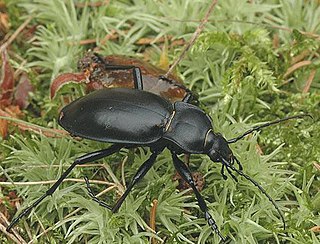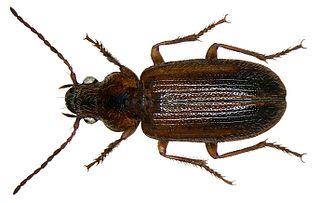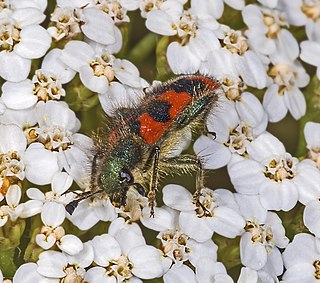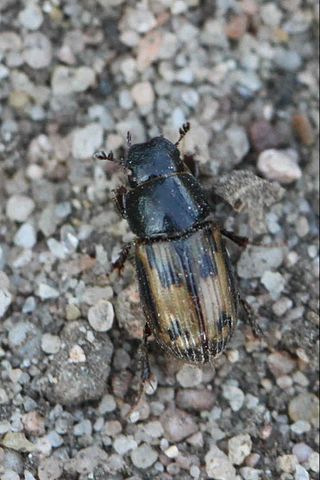
The Zopheridae family of beetles has grown considerably in recent years as the members of two other families have been included within its circumscription; these former families are the Monommatidae and the Colydiidae, which are now both included in the Zopheridae as subfamilies or even as tribe of subfamily Zopherinae. Some authors accept up to six subfamilies here, while others merge all except the Colydiinae into the Zopherinae.

Corticaria is a genus of beetles in the family Latridiidae, containing the following species:

Carabus is a genus of beetles in family Carabidae. The genus is highly diverse with 94 subgenera, 959 species and 2300 subspecies, thus is the largest genus in the subfamily Carabinae. The vast majority are native to the Palearctic, but 16 Nearctic species are also known. Carabus spp. are 12–50 mm (0.47–1.97 in) long, and most species are wingless and often very colourful. These are nocturnal, predatory beetles that feed on snails, earthworms, and caterpillars. Most Carabus species were thought to have inhabited the Eurasian forest, but the species' low dispersal abilities altered the distribution of lineages within the genus.

Harpalus is a genus of ground beetle first described by Pierre André Latreille in 1802.

Dasyboarmia is a genus of moths in the family Geometridae.

Cymindis is a genus of ground beetle native to the Palearctic, the Near East, and North Africa. It contains the following species:

Attagenus is a genus of beetles. This genus is found in tropical Africa, the Palearctic including Europe, the Near East, the Nearctic, North Africa and East Asia. There are nearly 200 species. The genus has existed for at least 99 million years, with fossils known from the Cenomanian aged Burmese amber and Turonian aged New Jersey amber.

Alexiidae is a family of beetles. It contains a single genus, Sphaerosoma, formerly included within the family Cerylonidae, with around 50 species which are native to the western Palearctic. Species of Sphaerosoma are very small, around 1 to 2 mm in length rounded beetles with clubbed antennae. They are fungivores, having been observed feeding on mushrooms, and have been also been found in leaf litter and on decaying bark.

Dicheirotrichus is a genus of beetles in the family Carabidae, containing the following species:

Agapanthia is a genus of flat-faced longhorn beetle belonging to the family Cerambycidae, subfamily Lamiinae.

Clytini is a tribe of beetles in the subfamily Cerambycinae, containing the following genera:
Cymindis corax is a species of ground beetle in the subfamily Harpalinae. It was described by Reitter in 1889.
Cymindis impressa is a species of ground beetle in the subfamily Harpalinae. It was described by Reitter in 1893.
Cymindis kalavrytana is a species of ground beetle in the subfamily Harpalinae. It was described by Reitter in 1884.
Cymindis triangularis is a species of ground beetle in the subfamily Harpalinae. It was described by Reitter in 1897.
Cymindis walteri is a species of ground beetle in the subfamily Harpalinae. It was described by Reitter in 1889.

Trichodes is a genus of checkered beetle belonging to the family Cleridae, subfamily Clerinae.

Hemicrepidius is a genus of click beetle belonging to the family Elateridae.

Aphodiini is a tribe of aphodiine dung beetles in the family Scarabaeidae. There are more than 250 genera and 2,200 described species in Aphodiini.
Aphilenia is a genus of leaf beetles in the subfamily Eumolpinae. It is distributed in Central and East Asia as well as southern Russia. Members of the genus are adapted to dry climates, and feed on bushes of the genus Calligonum. In 2012, the genus was moved from the tribe Bromiini to the tribe Nodinini.













